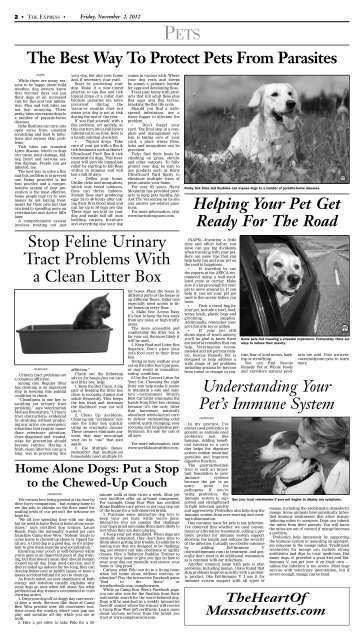November 02, 2012 - Southbridge Evening News
November 02, 2012 - Southbridge Evening News
November 02, 2012 - Southbridge Evening News
You also want an ePaper? Increase the reach of your titles
YUMPU automatically turns print PDFs into web optimized ePapers that Google loves.
2 • THE EXPRESS • Friday, <strong>November</strong> 2, <strong>2012</strong><br />
PETS<br />
The Best Way To Protect Pets From Parasites<br />
(NAPS)<br />
While there are many reasons<br />
to be happy about mild<br />
weather, dog owners know<br />
that warmer days can put<br />
their dogs at an increased<br />
risk for flea and tick infestation.<br />
Flea and tick bites are<br />
not just annoying. These<br />
pesky bites can expose dogs to<br />
a number of parasite-borne<br />
diseases.<br />
Itchy fleabites can turn into<br />
open sores from constant<br />
scratching and lead to infections<br />
and serious skin problems.<br />
Tick bites can transmit<br />
Lyme disease, which in dogs<br />
can cause joint damage, kidney,<br />
heart and nervous system<br />
damage. People can get<br />
infected, too.<br />
The best way to solve a flea<br />
and tick problem is to prevent<br />
one. Being proactive is the<br />
best practice and a comprehensive<br />
system of pest prevention<br />
is the most effective.<br />
Some people may try to save<br />
money by not buying treatments<br />
for their pets but that<br />
can lead to spending more on<br />
veterinarian and doctor bills<br />
later.<br />
A comprehensive system<br />
involves treating not just<br />
your dog, but also your home<br />
and, if necessary, your yard.<br />
Start by protecting your<br />
dog. Make it a year-round<br />
practice to use flea and tick<br />
topical drops or a collar. Just<br />
because parasites are more<br />
prevalent during the<br />
warm–er months does not<br />
mean your dog is not at risk<br />
during the rest of the year.<br />
If you find yourself with a<br />
flea problem, act quickly, as<br />
this can turn into a full-blown<br />
infestation in no time. Here is<br />
a handy solution checklist:<br />
• Topical drops. Take<br />
care of your pet with a flea &<br />
tick treatment such as Hartz®<br />
UltraGuard Pro® flea & tick<br />
treatment for dogs. This treatment<br />
will provide immediate<br />
relief by starting to kill fleas<br />
within 15 minutes and will<br />
last a full 30 days.<br />
• Deflea your home.<br />
Unlike ticks and mosquitoes,<br />
which only breed outdoors,<br />
fleas can thrive indoors.<br />
Female fleas start producing<br />
eggs 24 to 48 hours after taking<br />
their first blood meal and<br />
can lay up to 50 eggs per day.<br />
These eggs are laid on your<br />
dog and easily fall off onto<br />
bedding, carpets, furniture<br />
and everything else your dog<br />
comes in contact with. Where<br />
your dog rests and sleeps<br />
be–comes a primary habitat<br />
for eggs and developing fleas.<br />
Treat your home with products<br />
that kill adult fleas plus<br />
flea eggs and flea larvae,<br />
breaking the flea life cycle.<br />
Should you find a widespread<br />
infestation, use a<br />
home fogger to alleviate the<br />
problem.<br />
• Don’t forget your<br />
yard. The final step in a complete<br />
pest management system<br />
is taking care of your<br />
yard, a place where fleas,<br />
ticks and mosquitoes can be<br />
prevalent.<br />
Ticks find their hosts by<br />
climbing on grass, shrubs<br />
and other outposts. To fully<br />
protect your dog, be sure to<br />
use products such as Hartz<br />
UltraGuard Yard Spray to<br />
eliminate multiple types of<br />
pests outside your home.<br />
For over 85 years, Hartz<br />
Mountain has provided products<br />
to keep pets healthy. An<br />
Ask The Vet section on its site<br />
can answer pet-related questions.<br />
For more information, visit<br />
www.hartzultraguard.com.<br />
Pesky tick bites and fleabites can expose dogs to a number of parasite-borne diseases.<br />
Helping Your Pet Get<br />
Ready For The Road<br />
Stop Feline Urinary<br />
Tract Problems With<br />
a Clean Litter Box<br />
(NEWSUSA)<br />
Urinary tract problems are<br />
a common affliction<br />
among cats. Regular litter<br />
box cleaning is an important<br />
step in keeping this painful<br />
condition in check.<br />
“Cleanliness is one key to<br />
avoiding cat urinary tract<br />
problems,” says veterinarian<br />
Melissa Brookshire. “Urinary<br />
tract obstructions, evidenced<br />
by straining without producing<br />
any urine, are emergency<br />
situations that require immediate<br />
veterinary attention.<br />
Once diagnosed and treated,<br />
steps for prevention should<br />
become routine. Having a<br />
fresh, clean litter box can go a<br />
long way in preventing this<br />
affliction.”<br />
Check out the following<br />
advice for hassle-free cat care<br />
and litter box help:<br />
1. Keep the Box Clean. A big<br />
part of keeping the litter box<br />
clean is scooping clumps and<br />
solids frequently. This keeps<br />
the box fresh and increases<br />
the likelihood your cat will<br />
use it.<br />
2. Clean Up Accidents.<br />
Clean up any “accidents” outside<br />
the litter box quickly<br />
using an enzymatic cleaner.<br />
These cleaners eliminate any<br />
scent that may encourage<br />
your cat to “use” that spot<br />
again.<br />
3. Use Multiple Boxes.<br />
Remember that multiple-cat<br />
households need multiple litter<br />
boxes. Place the boxes in<br />
different parts of the house or<br />
on different floors. Older cats<br />
especially need access to litter<br />
boxes on every floor.<br />
4. Make Box Access Easy.<br />
It’s best to keep the box away<br />
from any noisy or high-traffic<br />
areas.<br />
The more accessible and<br />
comfortable the litter box is<br />
for your cat, the more likely it<br />
will be used.<br />
5. Keep Food and Litter Box<br />
Separate. Don’t place your<br />
cat’s food next to their litter<br />
box.<br />
Doing so may confuse your<br />
cat on the litter box’s purpose,<br />
or may result in unsanitary<br />
eating conditions.<br />
6.Use the Correct Litter for<br />
Your Cat. Choosing the right<br />
litter can help make it easier<br />
to maintain a safe and sanitary<br />
environment. World’s<br />
Best Cat Litter eliminates the<br />
hassle from litter box cleanup<br />
because it’s the only litter<br />
that harnesses naturally<br />
absorbent whole-kernel corn<br />
to deliver outstanding odor<br />
control, quick clumping, easy<br />
scooping and longlasting performance.<br />
It’s safe for cats of<br />
all ages.<br />
For more information, visit<br />
www.worldsbestcatlitter.com.<br />
Home Alone Dogs: Put a Stop<br />
to the Chewed-Up Couch<br />
(NEWSUSA)<br />
Pet owners love being greeted at the door by<br />
their furry companions -- but coming home to<br />
see the sofa in chunks on the floor amid the<br />
smiling jowls of our pet isn't the welcome we<br />
hope for.<br />
"We all love spending time with our dogs,<br />
but we need to leave them at home alone sometimes,"<br />
says certified dog trainer, Laura<br />
Roach, from the nationally trusted pet care<br />
franchise Camp Bow Wow. "Nobody wants to<br />
come home to chewed-up shoes or ripped furniture.<br />
A tired dog is a good dog, so it's important<br />
to give them exercise and socialization."<br />
Ensuring your pooch is well-behaved while<br />
you're gone is an important piece of dog training,<br />
but that doesn't mean they should remain<br />
cooped up all day. Dogs need exercise, and if<br />
they're holed up indoors for too long, they can<br />
develop behavioral or health issues or leave a<br />
messy accident behind for you to clean up.<br />
As Roach noted, an over abundance of both<br />
energy and boredom usually explains why<br />
some dogs go nuts when left alone. See what<br />
professional dog trainers recommend to curb<br />
chewing antics.<br />
1. Drop your dog off at doggy day care several<br />
days a week. Services like those at Camp<br />
Bow Wow provide over 100 convenient locations<br />
across the country, where your pup can<br />
play and socialize all day while you are at<br />
work.<br />
2. Hire a pet sitter to take Fido for a 30-<br />
minute walk at least twice a week. Most pet<br />
care facilities offer an at-home component.<br />
For example, Camp Bow Wow has certified<br />
Home Buddies care givers to get your dog out<br />
of the house for a well-deserved break.<br />
3. Purchase some interactive dog toys to<br />
keep your pet busy while you're gone.<br />
Interactive toys are puzzles that challenge<br />
your dog's mind and make them more likely to<br />
rest when they are done playing.<br />
4. Keep your pet stimulated. When dogs are<br />
mentally exhausted, they don't have time to<br />
think about getting into trouble. In addition to<br />
buying toys that are designed to be challenging,<br />
pet owners can take obedience or agility<br />
classes. Hire a Behavior Buddies Trainer to<br />
come to your home to give you tips on how to<br />
wear your dog out mentally and ensure your<br />
home is "dog proof."<br />
Curious what Fido can do to a living room<br />
when left home alone without exercise or<br />
attention? Play the interactive Facebook game<br />
"Bad to the Bone" at<br />
www.facebook.com/campbowwow.<br />
While on Camp Bow Wow's Facebook page,<br />
you can also vote for the finalists from their<br />
nationwide search for the worst-behaved dog.<br />
Dogs will be matched in a weekly interactive<br />
face-off contest where the winner will receive<br />
a Camp Bow Wow gift certificate. Learn more<br />
about various services from the brand you<br />
trust at www.campbowwow.com.<br />
(NAPS)—Investing a little<br />
time and effort before you<br />
leave can pay big dividends<br />
when traveling with your pet.<br />
Here are some tips that can<br />
help keep you and your pet on<br />
the road to happiness:<br />
• If traveling by car,<br />
the experts at the ASPCA recommend<br />
using a well-ventilated<br />
crate or carrier. Make<br />
sure it’s large enough for your<br />
pet to move around in. It can<br />
help if you let your pet get<br />
used to the carrier before you<br />
leave.<br />
• Pack a travel bag for<br />
your pet. Include a bowl, food,<br />
water, leash, plastic bags and<br />
grooming supplies.<br />
Additionally, remember your<br />
pet’s favorite toy or pillow.<br />
• If your pet still<br />
shows signs of travel anxiety,<br />
you’ll be glad to know there<br />
are natural remedies that can<br />
help. Veterinarian recommended<br />
and 100 percent natural,<br />
Rescue Remedy Pet is<br />
designed to help address a<br />
wide range of pet problems<br />
including anxious be–haviors<br />
from travel or change in routine,<br />
fear of loud noises, barking<br />
or scratching.<br />
You can find Rescue<br />
Remedy Pet at Whole Foods<br />
and anywhere natural products<br />
are sold. Visit www.rescueremedy.com/pets<br />
to learn<br />
more.<br />
Understanding Your<br />
Pet’s Immune System<br />
(NEWSUSA)<br />
Some pets find traveling a stressful experience. Fortunately, there are<br />
ways to reduce their anxiety.<br />
In my practice, I’ve<br />
always used probiotics in<br />
general as animals need<br />
probiotics just like<br />
humans. Adding beneficial<br />
bacteria to a pet’s<br />
diet helps the digestive<br />
system combat intestinal<br />
parasites and improves<br />
digestive function.<br />
The gastrointestinal<br />
tract is such an important<br />
foundation to pets’<br />
immune systems<br />
because the gut is an<br />
entry point for<br />
pathogens. If you’re<br />
using probiotics, the<br />
immune system is supported<br />
and strengthened<br />
See your local veterinarian if your pet begins to display any symptoms.<br />
to fight infection quickly<br />
mange, including the problematic demodectic<br />
and aggressively. Probiotics also help stop the<br />
mange. Some animals have genetically inherited<br />
immune weaknesses that allow mange-<br />
immune system from over-reacting and creating<br />
inflammation.<br />
inducing mites to overgrow. Dogs can inherit<br />
One common issue for pets is ear infection.<br />
the mites from their parents. You will know<br />
I’ve observed that whether we used conventional<br />
or alternative treatments, adding a pro-<br />
the mites are out of control if mange becomes<br />
a problem.<br />
biotic product for immune system support<br />
Probiotics help immensely by supporting<br />
shortens the length and reduces the severity<br />
the immune system in mounting an appropriate<br />
response to the mange mites. Traditional<br />
of the infection. I usually see a better outcome<br />
by adding Del-Immune V<br />
treatments for mange can include strong<br />
(www.delimmune.com) to treatment, and generally<br />
don’t need to do additional treatments,<br />
antibiotics and dips in toxic medicines. But<br />
many dogs, if provided a good diet and Delas<br />
is common with ear infections.<br />
Immune V, can get over it on their own —<br />
Another common issue with pets is skin<br />
unless the infection is too severe. Most dogs<br />
problems, including mange. I have found that<br />
survive with veterinary intervention, but if<br />
skin problems improve quickly with a probiotic<br />
product, like Del-Immune V. I use it for<br />
severe enough, mange can be fatal.<br />
immune system support with all types of<br />
TheHeartOf<br />
Massachusetts.com
















